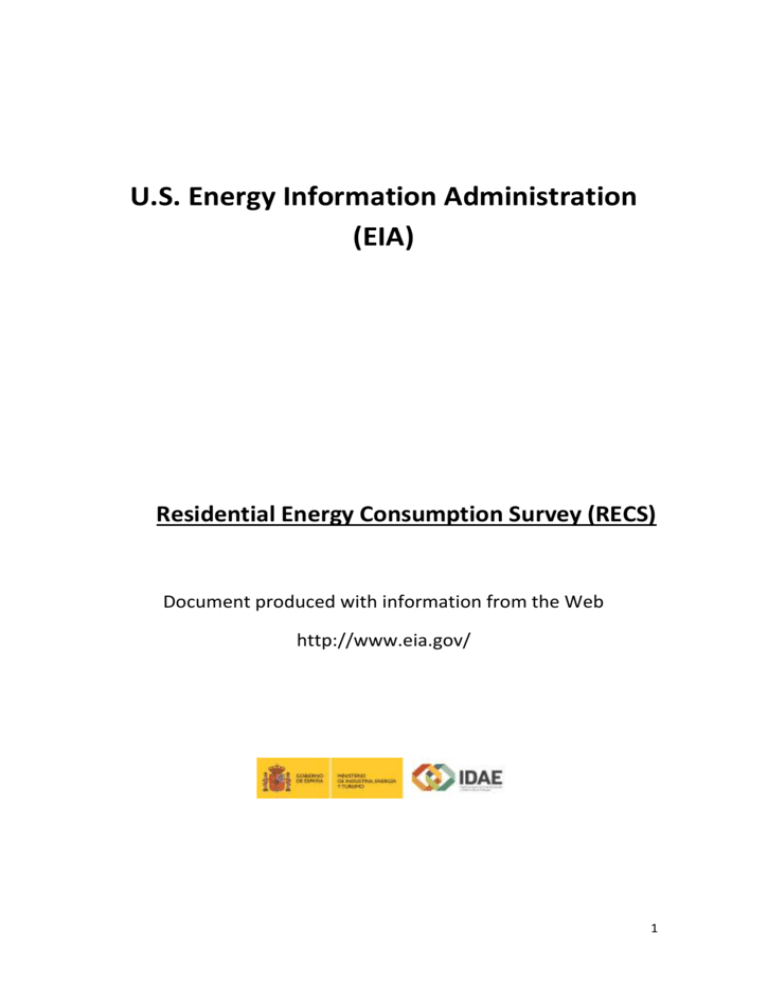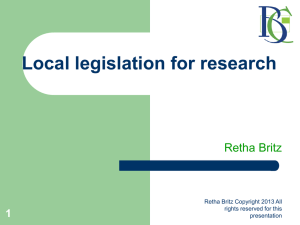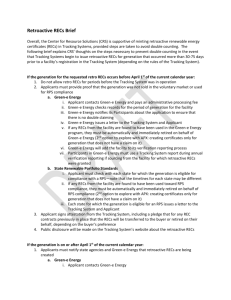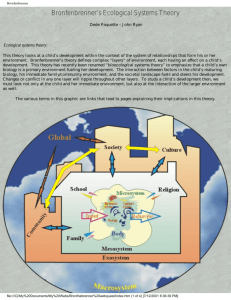USA_Residential_Statistics
advertisement

U.S. Energy Information Administration (EIA) Residential Energy Consumption Survey (RECS) Document produced with information from the Web http://www.eia.gov/ 1 EIA administers the Residential Energy Consumption Survey (RECS) to a nationally representative sample of housing units. Specially trained interviewers collect energy characteristics on the housing unit, usage patterns, and household demographics. This information is combined with data from energy suppliers to these homes to estimate energy costs and usage for heating, cooling, appliances and other end uses — information critical to meeting future energy demand and improving efficiency and building design. First conducted in 1978, the thirteenth RECS was conducted in 2009. The 2009 survey collected data from 12,083 households in housing units statistically selected to represent the 113.6 million housing units that are occupied as a primary residence. Data from the 2009 RECS are tabulated for the four Census regions, the nine Census divisions, and 16 States. These 16 States vary in their geography, climate, and population size. The results of each RECS include data tables, a microdata file, and a series of reports. Data tables are generally organized across two headings; "Household Characteristics" and "Consumption & Expenditures." See RECS data tables. The RECS and many of the EIA supplier surveys are integral ingredients for some of EIA's more comprehensive data products and reports, such as the Annual Energy Outlook (AEO) and Annual Energy Review (AER). These products allow for broader comparisons across sectors, as well as projections of future consumption trends. 2 Where does RECS square footage data come from? RECS 2009 — Release date: July 11, 2012 The size of a home is a fixed characteristic strongly associated with the amount of energy consumed within it, particularly for space heating, air conditioning, lighting, and other appliances. As a part of the Residential Energy Consumption Survey (RECS), trained interviewers measure the square footage of each housing unit. RECS square footage data allow comparison of homes with varying characteristics. In-person measurements are vital because many alternate data sources, including property tax records, real estate listings, and, respondent estimates use varying definitions and underestimate square footage as defined for the purposes of evaluating residential energy consumption. What areas are included in RECS square footage? In RECS, total square footage is a measurement of the two-dimensional area of the housing unit that is enclosed from the weather, including exterior walls. This is also the area where residential energy-consuming activities occur. Total square footage consists of four areas: attic, basement, garage, and rest of home. These four areas are separately measured by the interviewer because each may have its own heating and cooling 3 characteristics. Attics are only measured if they are heated, cooled, or finished. Garages are only measured if they are heated or cooled, and directly attached to the housing unit. Trained interviewers use a standardized method for measuring and collecting the dimensions of the housing unit. RECS housing units are measured during the in-person household interview. The respondent reports the number of stories in the housing unit, characteristics of the basement, attic, or garage, and the shape of each floor. Then the interviewer uses a measuring tape to collect the dimensions of each floor of the housing unit. Ideally, measurements are taken outside the housing unit to capture the total area of the home. Where outside measurements are not possible (for example, a high-rise apartment building), inside measurements are taken and adjusted for wall thickness after the interview. For standard shaped floors (square, rectangle, T-, or L-shaped), the dimensions are recorded as part of the questionnaire on the interviewer's laptop. For floors with non-standard shapes, the interviewer sketches the shape on graph paper and records the necessary dimensions on the sketch. How are RECS square footage variables calculated? Using the dimensions and sketches collected during the interview, a number of square footage components are calculated, including each floor's area; attic, basement, and garage areas where applicable; and heated and cooled spaces. Analysts later reviewed unexpected or unusual values, as well as interviewer comments. When appropriate, dimensions were corrected to accurately reflect the size and shape of the housing unit. Missing measurement data is imputed. EIA uses a statistical process called hot-deck imputation, where a case with missing data is randomly assigned the same data value as a similar case. Characteristics such as housing unit type, number of stories, and number of rooms are used to locate donors in the same "statistical neighborhood". RECS provides the best square footage data for understanding residential energy consumption Due to a variety of factors, RECS square footage estimates may not be appropriate for comparison with other data sources. Most other surveys, including the American Housing Survey, rely on respondent estimates of a housing unit's size. Property tax records and real estate listings often rely on in-person measurements, but included areas differ by jurisdiction and housing unit type. Analysis conducted by EIA suggests alternate data sources and respondent estimates of square footage are typically much smaller than RECS measurements. For example, unfinished basements are not commonly included in measurements used for property tax assessments. Unfinished basements are an important part of RECS square footage because they often contain major conditioning equipment and/or ductwork; thus, the 4 area contributes to the housing unit's energy consumption and intensity. Most respondents underestimate the size of their home as compared to the RECS measurement. The magnitude of this error is related to the housing unit type and other characteristics of the home, including the presence of basement, attic, and garage areas. 5 How does EIA estimate energy consumption and end uses in U.S. homes? RECS 2009 — Release date: March 28, 2011 EIA administers the Residential Energy Consumption Survey (RECS) to a nationally representative sample of housing units. Specially trained interviewers collect energy characteristics on the housing unit, usage patterns, and household demographics. This information is combined with data from energy suppliers to these homes to estimate energy costs and usage for heating, cooling, appliances and other end uses – information critical to meeting future energy demand and improving efficiency and building design. RECS uses a multi-stage area probability design to select sample A multi-stage area probability design ensures the selection of a representative sample ofhousing units in the United States. All housing units in the 50 States and the District of Columbia that are occupied as primary residences are eligible to be included in the RECS sample. 6 Sample selection begins by randomly choosing counties. The selected counties are then sub-divided into groups of Census blocks called segments and a sample of segments is randomly drawn from the selected counties. Within each selected segment, a list of housing units (sample frame) is created by field listing.1 The final sample of housing units is randomly selected from the housing unit frame constructed from the selected area segments. This type of sampling is called a multistage area probability design. Its proper application ensures that the selected sample represents the entire population of occupied housing units in the United States. The number of counties, segments, and housing units to be selected are carefully controlled so that RECS produces estimates of average energy consumption at specified levels of precision within the following geographic levels, called domains: National, Census Region, Census Division, and individual states or group of states within Census Divisions. An almost three-fold increase in sampled housing units is expected to result in more precise estimates of average energy consumption in 2009 2005 2009 180 430 Segments 1,450 3,000 Census blocks 2,430 5,420 Housing units 4,380 12,100 Counties Two surveys capture energy characteristics for sampled housing units: the Household Survey and the Rental Agent Survey In the Household Survey, trained interviewers use a standardized questionnaire to collect data from the selected housing units. The field interviewer uses a laptop to record the householder's responses to the survey. This method of collecting data is called Computer-Assisted Personal Interview (CAPI). Questions in the Household Survey are designed to collect energy-related characteristics of the housing unit ("What is the main fuel used for heating your home?"), as well as energy usage patterns of the household members ("How often is your dishwasher used?"). Where respondents in rental housing units are less sure of their housing unit's energy characteristics, EIA uses the Rental Agent Survey. Those data are collected by phone or in person from the unit's landlord or his/her representative. 7 All of the data collected from the Household and Rental Agent Surveys go through a series of rigorous statistical processes to ensure the highest possible data quality. These processes include: editing validation and quality control imputation of missing data EIA collects consumption and expenditure data from energy companies through the Energy Supplier Survey After the Household and Rental Agent Surveys are completed, EIA conducts the Energy Supplier Survey (ESS). ESS is a follow-on mail survey2 required of energy companies that serviced housing units in the Household Survey. ESS gathers data on how much electricity, natural gas, fuel oil, and propane were consumed by the sampled households during the reference year. ESS also asks for actual dollar amounts spent on these energy sources. Data from the ESS follow the same quality assurance procedures as those from the Household and Rental Agent Surveys. Did You Know? According to the American Community Survey, in 2009 there are about 113.6 million occupied housing units in the United States. About 19,000 were selected for RECS interviews but only about 15,300 were occupied primary residences and eligible for RECS. Of these, about 12,100 responded to the survey, a response rate of about 79%. EIA produces estimates of end uses of energy by modeling the data from the Household and Energy Supplier Surveys The flagship product of RECS is the estimate of how much energy is used within the home for heating, cooling, refrigeration, and other end uses. EIA uses RECS to estimate end-use consumption through a non-linear statistical model applied to data from the Household and Energy Supplier Surveys, which disaggregates total energy consumption into end-use components. These estimates of energy end uses make RECS uniquely important: it is the only survey that provides reliable, accurate and precise trend comparisons of energy consumption between households, housing types, and areas of the country. 8









